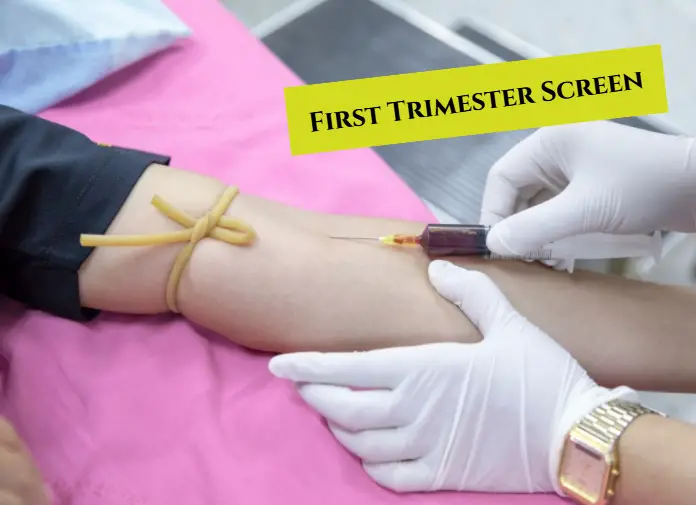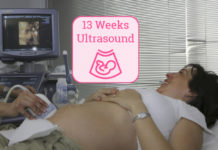First trimester screening is a relatively new two-part prenatal test, involving two steps. The optional prenatal test also known as nuchal translucency ultrasound assesses the risk of chromosomal defects.
The chromosomes are gene carriers which transfer your characters to your baby. Normally occurring in pairs chromosomes can delete or add on during formation of genetic material.
First trimester screen performed at the 11th week highlights the probability of having a baby with a genetic disorder. Compared to the second trimester Quad Screening, first-trimester screen doesn’t tell anything of neural tube defects.
Singapore Medical Journal in 2015 published an article about the effectiveness of nuchal translucency and FTS done together titled ‘Combined first trimester screen or noninvasive prenatal testing or both.’ 1

What is a first trimester screen?
The first trimester screen (FTS) is a prenatal test that uses blood test and ultrasound for detecting genetic abnormalities in the fetus. Mothers who have a history of genetic defects pregnancy or miscarriage must get the test. However, the test is only a screening and doesn’t tell anything about the actual condition. You may get a positive test and yet have a healthy baby or vice versa.
Some mums who are not ready to face the anxiety that comes along such screenings can skip the test. Others who are well sure of the chances can straightaway head for a diagnostic test. Amniocentesis and other invasive tests have a risk of miscarriage associated with them.
At times you can get a Quad or Triple screen test along with the first trimester screen in the transition week from first to the second trimester. In that case, the test will be a sequential screening and be more precise. First trimester sequential test is capable of detecting the risk of neural tube defects and Downs Syndrome.
An FTS comprises of estimating hCG and PAPP-A protein in maternal blood and nuchal translucency of the baby. Levels of hCG higher than normal mean that there are twins or risk of trisomy syndromes.
What is a screening test?
Any screening test is an assessment of risks, not disorder. FTS screens you for the presence of genetic diseases. It’s a quantification screening where you get to know the relative risk level as a ration. Other screenings such as a pregnancy kit only detect the presence. They don’t talk about how much.
How does risk from genetic disorders show up in screening tests?
All the human inheritance of traits like color, height, etc. is through genetic material. The blueprint of your body is your genetic material. Genes are small packs of genetic material arranged together on chromosomes. Every trait gets a gene copy from mother and father.
It’s only sex chromosomes in boys who don’t have a pair. Men have a Y chromosome which lacks one arm. The chromosomes replicate during cell division. Genetic defects arise when during this replication errors occur. Either something gets deleted, added, substituted or an entire chromosome vanishes or a new one comes.
For observing these changes in DNA, you need invasive tests or have to get a prenatal cell-free DNA test. Screening tests use markers (not sketch pens). Markers such as elevated or reduced levels of proteins and hormones are parameters of screening tests.
Every lab follows a standard cut off value for comparing the obtained values. Individuals who have more than the standard cut off are at higher risk than those with lower values. Most labs consider 1:250 chance of Downs Syndrome as the threshold, beyond this a baby has a high risk of having Downs Syndrome.
Remember that FTS alone cannot tell you exactly whether your baby has trisomy 21 or not.
What are the diagnostic tests?
Genetic defects in fetus occur when there is trisomy (3 chromosomes instead of a pair) or deletion. There are many reasons for such mutations either hereditary or due to exposure to radiation. During the life inside the womb, the baby shed a lot of cells and produces specific proteins that tell a lot. When these cells cross the placenta, they enter the mother’s blood.
A doctor can extract the genetic material from these cells and learn about the baby’s genetic makeup. Disorders due to problems in the DNA show up as abnormalities in the extracted gene pool from the cell. A single blood sample has enough genetic material to perform multiple tests.
Amniocentesis, Chorionic villus sampling, and cell-free prenatal DNA test are examples of diagnostic tests.
What does First Trimester Screen test?
FTS looks for PAPP-A, hCG and Nuchal Translucency:
1) PAPP-A
The placenta and baby produce this largest pregnancy-associated protein. Functions of PAPP-A 2 include protecting the fetus from the mother’s immune system, forming new blood vessels and mineralization.
- 32 DPO levels of PAPP-A start increasing
- Placental layer Syncytiocytotrophoblast is the production site along ovaries, luteal cells
- Doubling occurs every 2 days
- Keeps rising in decreasing pace until delivery
- Pregnancy week 5 have serum levels around 10 µg/L
- Acts on insulin growth factor responsible for the growth of the baby
- Also found in males
- Pregnant women serum have it bound to immune system proteins
Maternal high levels of PAPP-A indicate risk of Downs Syndrome. Reduced level of PAPP-A means that there are chances your baby might have Edwards Syndrome (Trisomy 18). Other indications of adverse pregnancy outcomes include Preeclampsia, stillbirth, premature birth, and intrauterine growth restriction3.
2) hCG
The first test that you take during pregnancy detection looks for hCG. Higher levels of hCG mean that you could be carrying twins. The low levels of hormone sign a threatened miscarriage or blighted ovum.
3) Nuchal Translucency
Nuchal translucency4 is the fluid under skin layers near the head and skin, and gynecologists can measure it during the ultrasound. Wider nuchal translucency is a sign of chromosomal disabilities and heart defects.
NT depends on the crown-rump length. As the baby grows the NT increases. Levels of NT tell about both structural deformities and chromosomal aneuploidy (abnormal number of chromosomes).
4) Crown Rump Length
Measurement of the length from top of head to the buttock is CRL ratio. At every stage of pregnancy, the CRL must be of certain value. First trimester screen estimates the age of the baby using the CRL ratio.
The sex determination from the first-trimester screen is not as reliable as you need to wait until the 16th week. Doctors do predict the gender, you better trust them at your risk.
When is the First Trimester Screen done?
First Time Screening is generally done between the 11-14th week of pregnancy. Some women who avoid getting multiple prenatal tests don’t get it until the 14th week. Later along with Quad screen, they get the test as integrated screening.
First Trimester Screen is optional, and you can skip it as per will.
How is the First Trimester Screen performed?
There are no elaborate procedures or invasive steps in a first-trimester screen. The blood test is for the mother and nuchal translucency ultrasound for baby.
Before the test
You can eat or drink anything before getting the first-trimester screen. Make sure you are ready mentally for the anxiety that is going to come along with the results. You could get a result that calls for further genetic testing. Just in case you don’t want to take any invasive tests then FTS will serve you no good.
Discuss with your counselor about the pros and cons of First Trimester Screening during pregnancy. Practically mothers who don’t think results would affect the course of their pregnancy can skip the test. It’s not expensive like other tests and most health insurances cover it.
Treatments for genetic defects in the fetus while in the womb are not successful often.
During the test
For hCG and PAPP – A test – Your doctor will find a suitable vein to draw a sample of blood from. The sample will take a week for testing and giving you the results.
Smoking can affect the accuracy of the First Trimester Screen.
For Nuchal translucency – Commonly a woman goes through many ultrasound scans when pregnant. This one would feel no different. By the 11th week, you don’t need a full bladder for seeing inside the belly. The sonographer will place a transducer with some gel on your lower abdomen and move around the device.
Ultrasound waves will come out and reflect from different parts of your baby. An image appears on the screen, and you can see your little one, hear the heartbeat and cry tears of joy.
The perinatologist will see the amount of fluid surrounding your baby’s head and neck. If the fluid is more and NT is wider than normal, then it could mean that it is a high-risk pregnancy.
After the test
You will get a report with figures like 1:xyz risk for Down’s Syndrome, Edward Syndrome and trisomy 13. Soon there will be follow up appointment where your OB will brief you about the results.
Remember that the results are not final and have cases of false negatives and positives. A false negative result means that despite you have the condition, but your test says no.
What do First Trimester Screen Results Mean?
First-trimester result such as 1:1000 risk means that out of 1000 women like you only 1 would have a baby with chromosomal defects. When you take FTS along with Quad Screen, you also come to know of specific proteins and their levels.
Look at the results in an alternative manner, like 1:300 implies you have a risk higher than 1:1000 but lower than the cut off 1:250. A lot of factors like mothers age, race, weight, past pregnancies and prescription also affect results.
Another way to understand the results is that having a 1:100 risk would mean it’s 99% likely that your baby is safe.
Every test has its limitations, and the cases of false results make it essential that you talk with your OB about it.
Abnormal results: High-Risk First Trimester Screen
After getting these results, you can go to have a level 2 ultrasound which is more detailed to look for nuchal translucency. Other tests such as amniocentesis looking for amniotic fluid and CVS testing the tissue from placenta reveal more.
Normal Results: Low-Risk First Trimester Screen
Chances for having a birth defect are less but not zero. Remember only 85 out of 100 women will know if they have a high risk. Rest 15 wouldn’t know it but can have a high risk of trisomy or monosomy disorder.
What are the risks of First trimester screen?
No risks are reported from taking an FTS during the 11th – 14th week of pregnancy. These tests only have psychological challenges that come along such as decision making. You have to decide for yourself whether you want to learn about the risk or be an ostrich mama.
Parents who elect out of having such tests have healthy babies and some face disappointment too.
How accurate is the First trimester screen results?
The screening is 85% accurate for determining the risk of Downs Syndrome. That means that out of 100 results 25 are not correct. And amongst them are false positive with their taxing mental tyranny. They make you panic take a lot of other tests and live with anxiety.
Remember that positive doesn’t mean your baby has the disorder. It could mean anything above 1:200 chance of having trisomy 121, 17, or 13.
Why should I get a First Trimester Screen?
After getting an FTS, you will be able to decide the future course of your pregnancy. One can prepare for a baby with the calculated probability of having abnormalities. Generally, a pregnant mother gets a clearer idea of further testing she needs after it. Couples who get sad news can contemplate elective abortion based on their personal choices. A dating scan also will tell you about the time left until the baby comes in your life.
How should you decide whether you must get FTS or not? If you are above 35 years and are nulliparous (never given birth) due to uncontrolled causes, consider getting it.
You can ask yourself how the results would affect you and your decision to have the baby. Are you willing to get a diagnostic test after this first-trimester screen like amniocentesis? Can you bear the anxiety until term if you find any negative results?
Footnotes
- https://www.ncbi.nlm.nih.gov/pmc/articles/PMC4325569/#__ffn_sectitle
- Hill, M.A. (2018, October 28) Embryology Pregnancy-associated plasma protein-A Accessed: https://embryology.med.unsw.edu.au/embryology/index.php/PrPregnancy-associated_plasma_protein
- Early Pregnancy Levels of Pregnancy-Associated Plasma Protein A and the Risk of Intrauterine Growth Restriction, Premature Birth, Preeclampsia, and Stillbirth. The Journal of Clinical Endocrinology & Metabolism, Volume 87, Issue 4, 1 April 2002, Accessed: https://academic.oup.com/jcem/article/87/4/1762/2374978#
- Normal reference range of fetal nuchal translucency thickness in pregnant women in the first trimester J Res Med Sci. 2015 Oct; 20(10): 969–973 Accessed: https://www.ncbi.nlm.nih.gov/pmc/articles/PMC4746871/#__ffn_sectitle









